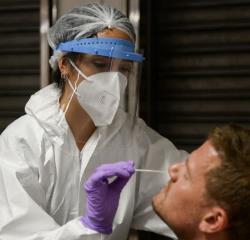 ProMed Mail has reported on a comprehensive review article published in EuroSurveillance* interpreting the results of molecular assay for SARS-CoV-2. The authors affiliated with The Center for Infectious Disease Control in the Netherlands, Erasmus University and the Global Outbreak Alert and Response Network in Switzerland identified 264 publications relevant to molecular diagnostic technology. The data set contained 32,515 COVID-19 cases and the authors aggregated data from 217 adults representing 2,777 samples.
ProMed Mail has reported on a comprehensive review article published in EuroSurveillance* interpreting the results of molecular assay for SARS-CoV-2. The authors affiliated with The Center for Infectious Disease Control in the Netherlands, Erasmus University and the Global Outbreak Alert and Response Network in Switzerland identified 264 publications relevant to molecular diagnostic technology. The data set contained 32,515 COVID-19 cases and the authors aggregated data from 217 adults representing 2,777 samples.
With respect to the kinetics of SARS-CoV-2 and the respiratory tract the authors concluded that the virus replicates in the throat and upper respiratory tract. Samples for diagnostic purposes should be collected early in the course of the infection as viral load peaks within a few days of infection. The virus can be detected in respiratory samples for up to six weeks in cases with mild disease and eight weeks in cases with severe disease. Higher viral load was determined in sputum compared to nasopharyngeal and oropharyngeal swabs.

Gastrointestinal shedding is a characteristic of COVID infection and viral RNA can be detected in the absence of gastrointestinal symptoms. Prolonged viral detection in feces occurs and may persist for longer than seven weeks following resolution of symptoms and after clearance from the respiratory tract. In this respect, SARS-CoV-2 is similar to infectious bronchitis of chickens. IBV can be isolated from cecal tonsils after resolution of clinical signs and failure to isolate the virus from the upper respiratory tract. Fecal shedding of SARS-CoV-2 is the basis of surveillance of sewage as a means to detect the presence of COVID in a group environment or localized region.
The authors concluded that self-collected saliva could be used as an alternative to swabs from the upper respiratory tract since the virus is present in oral fluid for up to four weeks following infection. SARS-CoV-2 RNA is generally not present in urine but has been detected in semen. Since the epidemiology of COVID-19 has yet to be completely characterized, diagnosis should be based on an appreciation of the strengths and limitations of molecular biologic testing including amplification and clinical presentation.
*Stanoeva, K.R.et al Towards a sensitive and accurate interpretation of molecular testing for SARS-CoV-2: a rapid review of 264 studies Eurosurveill.2021; 26 (10).doi.org/10.2807/14560-7917.ES.2021.26.10.2001134.